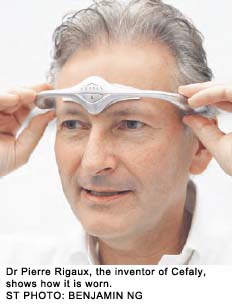Nerve Stimulation Device May Reduce Migraines
 Migraine headaches are a neurological condition in which throbbing headaches (usually on one side of the head) are accompanied by other symptoms such as nausea and sensitivity to light or sound. A recent study suggests that a device worn as a headband that can stimulate the trigeminal nerve through the skin can reduce incidence of migraines. The device, called Cefaly, is produced by Belgian company STX-Med.
Migraine headaches are a neurological condition in which throbbing headaches (usually on one side of the head) are accompanied by other symptoms such as nausea and sensitivity to light or sound. A recent study suggests that a device worn as a headband that can stimulate the trigeminal nerve through the skin can reduce incidence of migraines. The device, called Cefaly, is produced by Belgian company STX-Med.
In the randomized controlled study by Schoenen et al. published in Neurology this year, using the device for 20 minutes a day for 3 months reduced migraine days by 25% and reduced migraine attacks by 19%. Sixty-seven patients who had at least 2 migraines per month were randomized to receive either treatment with the Cefaly device or a sham stimulation that caused a tingling sensation without stimulating the trigeminal nerve.
Schoenen told Medscape Medical News that the device may be a useful addition to current treatments, and has the benefit of not producing side effects.
The device is already available in Europe, Canada, and several South American and Middle Eastern countries. It is currently awaiting approval in the US. In those countries where it is approved, it does not require a prescription and can be bought directly by a patient at a cost of €295 or $299 (CAD).
Ketamine Effective in ECT-Resistant Depression
 In an abstract presented at the Society of Biological Psychiatry meeting in May, Lobna Ibrahim and Carlos Zarate of the National Institute of Mental Health reported that intravenous infusions of ketamine were effective in a majority of patients with highly treatment-resistant depression, i.e. even those who had been unresponsive to a course of electroconvulsive therapy.
In an abstract presented at the Society of Biological Psychiatry meeting in May, Lobna Ibrahim and Carlos Zarate of the National Institute of Mental Health reported that intravenous infusions of ketamine were effective in a majority of patients with highly treatment-resistant depression, i.e. even those who had been unresponsive to a course of electroconvulsive therapy.
Editor’s note: Few treatments have been explored for this subgroup of highly treatment-resistant patients, although some have been referred for experimental protocols with intracranial deep brain stimulation (DBS) and others have been successfully treated by Mark George and colleagues at the Medical University of South Carolina with very high intensity rTMS over the left prefrontal cortex (at 130% of motor threshold, 10 Hz stimulation). Further study is needed to determine what follow-up procedures can be used to sustain an acute response to ketamine, rTMS, or ECT for the long term. Read more
rTMS Effective in Major Depression
Mark George from the Medical University of South Carolina presented a sham-controlled, multi-site, randomized trial of repeated transcranial magnetic stimulation (rTMS) in 199 antidepressant-free patients with unipolar non-psychotic major depression. The rTMS was delivered to the left prefrontal cortex for 37.5 minutes at 120% of motor threshold (MT), with a 10 Hz, four-second train duration and 26-second inter-train interval, yielding 3000 pulses/session, with a figure-of-eight solid core coil. Compared with the sham treatment (which plays the same role a placebo would in a drug trial), active rTMS had a significant effect (p = .015), with 14% of patients remitting on the treatment compared with 5% on the sham procedure. Thus, the odds of attaining remission (the primary outcome measure) were several times greater with active rTMS than sham.
The number needed to treat (NNT), a measure of the number of patients who would need to be treated with active rTMS in order to get one more responder compared to the number of responders seen on sham rTMS (the smaller the number, the more effective the treatment) was 12. However, as in other previous studies, most of the remitters had prior low antidepressant-rated degrees of treatment resistance. When the blind study was complete and patients were openly given rTMS treatments (a practice known as open label extension), approximately 30% of the patients from each condition were able to achieve remission.
EDITOR’S NOTE: This large study, sponsored by NIMH rather than the pharmaceutical industry, confirms previous industry-related findings that active rTMS is more effective than sham in the treatment of major depressive disorder. These data also conform to recent meta-analyses of many smaller studies indicating that high intensity rTMS treatment is clinically effective for major depression. In prior rTMS studies, those with bipolar depression appeared to respond at about the same rate as those with unipolar illness, suggesting the possibility that these findings might also generalize to those with bipolar disorder, although this remains to be studied more systematically.
This study showed that patients with greater degrees of initial treatment resistance had less optimal outcomes to active rTMS. Some studies also show that electro-convulsive therapy (ECT) decreases in effectiveness in those with greater degrees of treatment-resistance. Response rates to ECT are approximately 40-50% in those with high degrees of treatment-resistance compared with 60-80% in those without. The rTMS data suggest that the treatment as studied may be a useful alternative to antidepressants for some patients with major depression, but it may not be an optimal approach for those with the highest degrees of treatment resistance. Further studies are warranted in patients with high treatment resistance in order to define optimal stimulation parameters that may be more successful for them.

